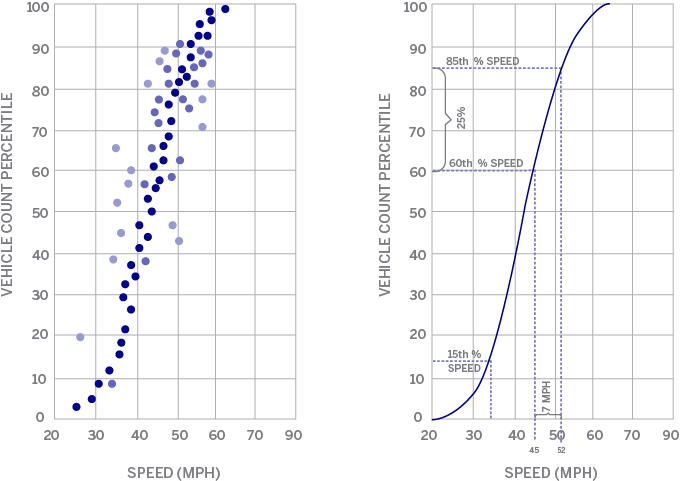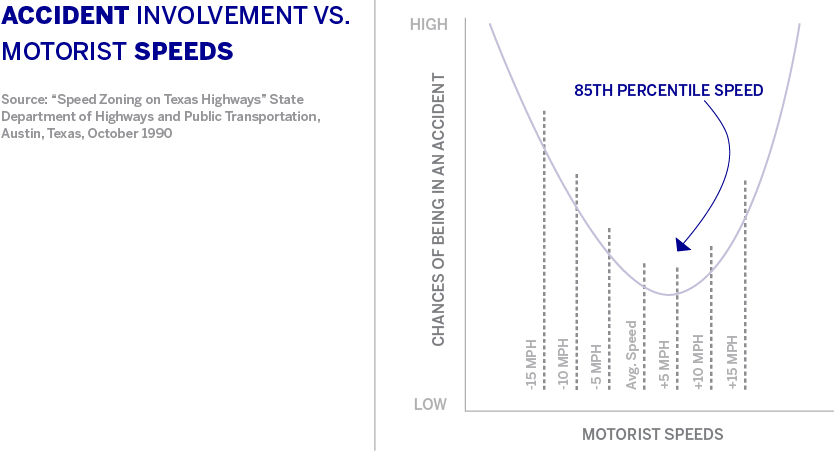In Texas you can drive 85 mph. In Pennsylvania, only 65 mph. In Wisconsin, interstate speed limits recently increased from 65 mph to 70 mph. Many highways across Minnesota have increased from 55 mph to 60 mph. Nevada raised the speed limits to 80 mph.
Why are there so many different speed limits? Why do speed limits continue to rise?
Road classification matters
First, and most logically affecting a speed limit on any given road, is how that road is classified. While actual roadway classifications vary by state, they can be reduced to three general types:
- Arterial have highest speeds and fewest access points (example: interstates with on-ramps and off-ramps).
- Collector are balanced for higher speeds but more access points (example: county roads).
- Local have low speeds, but high access (example: neighborhood street with driveways and many cross streets).
The differences among these classifications (speed as inversely proportionate to the amount of access points) explain why different speed limits are necessary. Roads with fewer intersections — with fewer travelers moving perpendicular to one another — can generally sustain higher maximum speeds and still be considered safe.
Roads with more intersections, and often more bikers and pedestrians, have more people moving at different speeds in different directions, and need lower maximum speeds.
But while speed limit decreases and traffic calming measures are being implemented on many local roads, interstate speeds have increased, and continue to increase, in many states across the country.
Why are these two occurrences, seemingly at odds with one another, happening at the same time?
The answer is the same for each. Safety.
Dispelling speed limit myths
Before explaining why interstate speeds are trending upward, let’s first expunge some misconceptions. Here are four commonly held, but inaccurate statements about speed limits:
- Lowering a posted speed limit will slow down traffic.
- Lowering a posted speed limit will increase safety and decrease the number of crashes.
- Raising the posted speed limit increases traffic speed.
- Drivers will always travel at 5 mph over the posted speed limit.
There is no guarantee that a speed limit will have any effect on driving behaviors. The fact is, when driving, most motorists choose a speed in which they personally feel both comfortable and safe.
As cars have evolved to go faster and be safer, so too has the inclination for drivers to increase speeds on open roads and rural interstates.
Simply, a speed limit sign should not dictate speed. It should reflect how drivers are actually behaving on the road. When you want drivers to slow down, you change the road through traffic calming measures like speed bumps or even design narrower roads, both of which make speedy drivers less comfortable.
How speed limits change
How do speed limits change? In most cases, speed changes, whether local or state, are the result of a study. A public agency conducts a spot speed study (also known as a speed zoning study) to document individual vehicle speeds along a specific road.
The speed data is then plotted on a chart that looks like the one pictured below at left. From this data, we want to know how fast the majority of motorists are actually driving. Specifically, how fast 85 percent of them are going.
The speed at which 85 percent of motorists travel is called “prevailing speed.” Prevailing speed is the major consideration when setting speed limits. Why? Because it is the safest.
Why is the 85th percentile of speed safest?
Imagine a car moving dangerously slow in the left lane, or a car weaving through traffic at extremely high speeds. These vehicles are unpredictable and dangerous. This is not solely due to their speed, because fast and slow are relative, but because of their speed in relation to other drivers.
As you can see in the graph below, safety decreases significantly as drivers deviate from the prevailing speed. You’ll see that high speeds, which increase more drastically than slower speeds, are less safe.
When prevailing speed goes up, the speed limit should follow it. So, in places like Minnesota and Maine, where speed limits are increasing by 5 mph, that increase is actually in direct response to the prevailing speed in the area. By increasing the speed limit, DOTs are working to make the roadways safer.
Conclusion
At first it seems counter-intuitive, but speed limits are going up on interstates and highways because motorists are driving faster on them. Speed limits are increased to help decrease unsafe speed variations among the fastest and slowest drivers.

